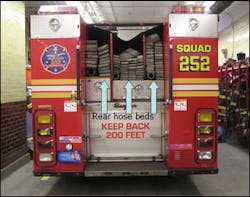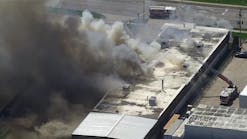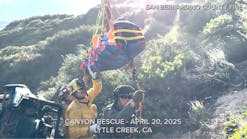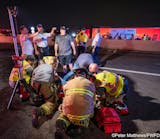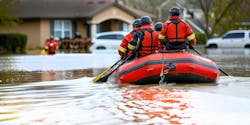Trics Of The Trade: The Rescue/Pumper and the FDNY Squad Concept - Part 1
In this first part of the squad company, we will talk about the mission as an engine company, a truck company, and as a rescue company for a structure fires.
What exactly is a rescue/pumper? The answer to a question like that is dependent upon where you are in the good Ole' U. S. of A. As I have traveled about and talked to people in regards to rescue/pumpers, I have inevitably heard a great variety of answers. Some were good and some were great.
The squad concept was actually used during the first and second world wars in New York City. Around 1955, when New York City saw a massive increase in fires, they returned. With the advent of civil unrest, the demise of good neighborhoods and the insurance companies unwittingly making it profitable to lose a building to fire, it was a perfect combination to start burning down the city. Unscrupulous landlords would hire a petty street criminal-turned arsonist for a mere pittance to go and start a fire in a building. Once the building was no longer inhabitable, the landlord hit for the big bucks. But the landlords weren't the only ones taking advantage.
The tenants were doing pretty good themselves. When they caught on to the fact that they would get relocation monies and services, furniture and clothes all on the back of the city, it seemed like everyone was doing it. Hence, the services of the FDNY were pressed and they needed more manpower. One of the solutions was to create squad companies as a supplemental manpower pool. Going from fire to fire to work at the bequest of the chief in charge, these squads did what ever was needed at the scene. They worked until the fire was declared "under control" and were released to go to the next working fire.
Alas, the squads of yesteryear are gone, all disbanded until Squad 1 emerged by themselves as a special unit around 1977. They were the only squad in New York City until 1998, when the city created six additional units for a total of seven squads companies placed strategically throughout the city.
The mission of a squad in the FDNY encompasses four of the fire service disciplines: engine work, truck work, rescue operations and hazardous materials operations. They are a highly specialized units, training in many technical disciplines as well as basic bread and butter operations. They are required to maintain multiple technician level standards in many areas, as is standard with all units assigned to the Special Operations Command.
In this first part of the squad company, we will talk about the mission as an engine company, a truck company, and as a rescue company for a structure fires. We will go through positioning, tasks, and what's expected of the members assigned to the squad when responding as an engine, truck or a rescue.
As I wrote this, Squad 252 finished working at a first due box a little while ago. They pulled up on a two-story wood-frame, 25-by-60-foot dwelling, with fire showing out all windows on the first floor and two windows on the top floor. Instead of transmitting a 10-75 (working fire signal) for this, the officer on duty ordered a second alarm because he had fire on two floors on arrival. They stretched in with a 1 3/4-inch hoseline for mobility and were backed up by Engine 233 with another 1 3/4-inch hoseline. Engine 271 used a third line to protect the stairwell and Squad 252 advanced on the first floor while Engine 233 advanced on the second floor. After a good push the fire started darkening down on both floors and shortly the battle was over.
Engine Company Duties
The squad, like standard FDNY engines, has a 1,000 gpm pump with a 500-gallon water tank on board. They are responsible for a first due area and operate according to established procedures as an engine within those boundaries.
As an engine, the squad carries a sufficient amount of hose to combat any type of fire in its first due areas and is capable of supplying large caliber streams as necessary. We carry enough foam to start and maintain a continuous foam operation for about 15 minutes, by then help should have arrived to supplement our supply.
Our equipment is inspected twice a day, at the start of each tour. The member assigned the nozzle position inspects all of the nozzles on the apparatus. This assures that they are in proper working order and in their proper places. We use smooth bore, solid stream nozzles (1 1/2-inch nozzle with a 15/16-inch tip for longer reach, superior penetration and reduced nozzle reactions.
On a 2 1/2-inch line we use the smooth bore for all of the same reasons in addition to its capability to perform well even at lower pressures, like standpipe operations. We do use a fog tip nozzle for trash fires and vehicle fires. We also carry a second fog tip in case it is needed when we would be stretching from another apparatus for a fire near electrical equipment or to disperse vapor and ventilate. The hose beds are checked to assure that the hose is still packed properly and the rolled or folded hose is still in working order.
The "chauffeur" is charged with apparatus cleanliness and functionality. The chauffeur will check the apparatus every tour to assure that it is in top response condition and ready to roll. He is responsible for apparatus positioning and making sure there is an available hydrant so he can get water to the nozzle team. And, because positioning on a city street can be difficult, he has to not only make sure he has a hydrant, he also needs to make sure that the other apparatus can attain their positioning too. You have the truck companies coming in and they would like to take position in front of the building, but, unfortunately that's not always possible. Between double parked cars encroaching into the hydrant area, an engine can only pull aside so far. Fortunately, if that happens sometimes we can radio ahead and the truck can come in from the other side of the block.
The "backup" is the position right behind the nozzle, moving in and providing physical as well as moral support. One of the major functions of this position is to make sure the line is flaked out before it is charged and ready to advance. Once the advance starts, the backup man is to try and adsorb as much of the nozzle reaction as possible, applying a forward thrust on the hoseline to counter the reaction of the nozzle. Maintaining a firm grip on the line and moving in conjunction with the nozzle man, yet at the same time knowing when to move in the opposite direction to assist directional change of the stream, requires a good solid firefighter.
The next position on the hoseline is the "door man." This position requires the member to remove the required amount of hose and drop it at a pre-determined spot. The pre-determined spot varies at each fire. This knowledge comes with time, experience and drilling. It is dependent upon the type of dwelling, size of the dwelling, the fire area, etc. Once he drops his lengths of hose, he follows the hoseline forward, removing any kinks, and going up to the door of the occupancy to feed the hoseline slowly into the advancing nozzle team, while keeping a little slack in the line so they can advance easily. He is also there to assist the nozzle team if they need relief or are injured. From this position he can easily move forward and assist an injured member or continue the attack. He can also alert the nozzle team if there is fire wrapping around, extending or cutting off their egress. Leaving a flashlight at the door on the ground could also give the inside team a reference point for the members leaving the fire area.
The last position on the line is the "control man." This is an extremely important position. The position assures that the correct amount of hose is stretched so the nozzle can reach the seat of the fire. This requires a member that is experienced enough and knowledgeable enough to correctly estimate the number of lengths required for the type of stretch being executed. The objective is to minimize the number of lengths of hose stretched to reduce friction loss and avoid kinks. Excessive hose will increase the chance for both while a short stretch will be embarrassing and require a whole additional evolution to resolve the problem.
He must take into account the distance from the apparatus to the building, the distance from the building entrance to the fire area, type of stairs and stretch being used to ascend the stairs and the size of the fire area. Once the proper amount of hose has been stretched, the control firefighter must disconnect the couplings and connect it to the pumper discharge. After this is complete the control firefighter will assist the chauffeur with the hydrant connection, if not complete already, and then move forward on the line feeding slack and making sure there are no kinks all the way to the door man. Once he meets up with the door man, they act as a team to relieve or assist the nozzle team as necessary.
If the squad arrives second due at an engine box they will assist with the stretching off the first line unless ordered to stretch a second line. It is of utmost importance that the first line gets stretched and placed in operation to get water on the fire. If it is a short stretch the incident commander may order the second engine to start a second line, otherwise the third engine will stretch it. The chauffeur will assure that the first engine has water and secure a second water source, taking a position at a second hydrant in case the first one is out of service.
Truck Company Duties
When the squad arrives at a working structural fire before the first or second due truck company, the company will act as a truck to fill the open position. In the case of a first due truck company the officer, forcible entry man and can man will provide forcible entry and search for the fire to facilitate the engine company's operation. Once the fire location is determined they will attempt to determine the boundaries of the fire, attempt to confine the fire and conduct searches for life.
The member riding in the "hook" position will perform outside ventilation when appropriate, dependent upon the type of occupancy, and using a portable ladder, fire escape, or other means of entry, he will enter the building to initiate a two-pronged attack in the search for fire and life.
The "roof man" will perform roof ventilation, size up the building from above and communicate any information deemed necessary to the officer. He will also carry a rope to the roof in case there are people trapped in an area where they have no means of egress and are trapped. In this case he will relay this information to the troops inside and initiate a roof rope rescue to remove these people from harms way via the outside of the building on a rope.
The "chauffeur" will secure the apparatus and operate as directed by the squad officer. He can assist on the floor above, the roof or the fire floor, where ever the officer deems he will have the greatest impact.
If the squad arrives at a working fire and the first due truck is on the scene and the second due truck is delayed, they will operate as the second due truck. This position can be precarious. According to our SOP's, the second due truck company operates on the floor above the fire. The officer and the forcible team will go directly above the fire, force entry and begin searching for life. They will check for extension and communicate to command any pertinent information they may need in making their decisions.
The "hook" will gain entry from the outside of the building on the floor above, once again, initiating the two-pronged attack and the "roof man" will join the first due "roof man" to assist in any duties not yet completed, bringing a roof saw to this position. In this situation the squad chauffeur will go to the fire floor and monitor conditions, transmitting any information that may be critical to the members operating on the floors above.
Rescue Company Operations
When the Squad arrives at a working fire and all of the companies are in their proper response positions, they are to operate as a rescue company. They will report in to the incident commander and operate as ordered. This is where the squad usually will operate using a three team concept. The teams consist of the "Squad Officer" and the "Squad Can Man" going to the fire floor, the "Squad Hook" and the "Squad Irons" going to the floor above and the "Squad Roof" and the "Squad Chauffeur" as a roof team. These teams are not a hard and fast rule but a basic SOP.
Most of the time, in the Squad I work in, the roof man will go to the roof and the chauffeur will go to the fire floor and monitor conditions to assure the safety of the troops operating above. The teams are there to support the existing assignment and fill the holes. As you know, sometimes there is more work than there are personnel. This is where the members will complete tasks not yet done to assure that the parameters of our operating procedures are fulfilled.
When there is a member down or the chief has all companies assigned to their tasks and there are still critical assignments that need to be accomplished, the chief will assign the squad as he sees fit. These types of operations demand flexibility and integrity, not freelancing. Training and knowledge of your job, your position, and the positions of all the other members on the fireground are necessary to enable this type of flexibility and integrity.
Being part of a Special Operations Unit means never saying you can't. It means continual training, over and over, on all of the disciplines. Sometimes this seem redundant, but when the chips are down and a chief officer looks to you to get certain tasks done, you know that your company is trained and capable of completing the tasks at hand, safely and competently.
This is just some of the basics of firefighting and how the FDNY Squad works in the capacity of an engine, truck or rescue company. The next installment of "Trics of the Trade" will talk about how the squad works in the capacity of a rescue company for technical incidents.
The stuff above is only good if you train and use the techniques on a regular basis. Regular training keeps you sharp. The actions become second nature. Use them, they are just some more...Trics of the Trade.
Related:
